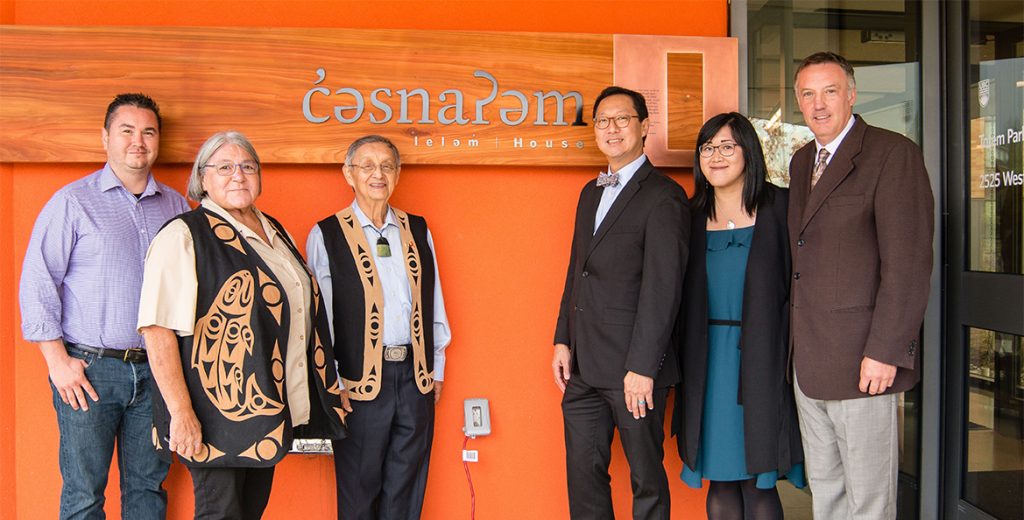October 9, 2017 – At a wonderful and moving unveiling ceremony on Wednesday, September 27, the new name for Building 7 at Totem Park Residence was gifted to UBC and UBC Student Housing and Hospitality Services (SHHS) by the Musqueam Nation. SHHS is so honoured to be gifted this very important name in Musqueam history and culture: c̓əsnaʔəm House, or c̓əsnaʔəm leləm̓.
It is so important that all understand the significance of this gift as well as the meaning of the name and proper pronunciation and use. Please take some time to read the below information about hən̓q̓əmin̓əm̓, the Musqueam language and the meaning, importance, and pronunciation of c̓əsnaʔəm.
About the Musqueam language: hən̓q̓əmin̓əm̓
The Musqueam community formally adopted the North American Phonetic Alphabet (NAPA) because of its specialized symbols that are designed to be an accurate language documentation and teaching tool. The Musqueam language, hən̓q̓əmin̓əm̓, contains 36 consonants, 22 not appearing in English and some appearing in only a handful of languages around the world.
How to pronounce c̓əsnaʔəm:
c̓ = “ts” sound, as in nuts, with a slight popping sound marked by the apostrophe
ə = the u in “but”
a = the a in “father”
ʔ = a consonant with no sound, like the space in “uh-oh”
The consonants “s”, “n” and “m” are the same in both English and hən̓q̓əmin̓əm̓
How to pronounce leləm̓:
The consonant “l” is the same in both English and hən̓q̓əmin̓əm̓
e = the e in “bet”
ə = the u in “but”
m̓ = the apostrophe signifies glottalization, which produces a creaky sound quality
View the pronunciation video with Musqueam Elder Larry Grant, and go more in-depth with the sounds of the hən̓q̓əmin̓əm̓ alphabet.
How to type c̓əsnaʔəm həm̓ləsəm̓, q̓ələχən or other words in hən̓q̓əmin̓əm̓:
If you are in a role that involves regular communication with the names gifted by Musqueam, the First Nations Unicode Font will be a great tool for you to have, as it provides keyboard shortcuts. The font is available to download for Windows or Macintosh users for free from the UBC First Nations and Endangered Languages Program website. If you have inquiries in terms of downloading or using the font, please contact Sarah Ling.
What does c̓əsnaʔəm mean?
The following description of c̓əsnaʔəm, provide by Musqueam, is featured on a commemorative bookmark given out at the naming ceremony, and to the residents:
c̓əsnaʔəm, one of our Musqueam villages, existed on the stal̕əw̓ (now called the Fraser River) long before Vancouver was founded. For over 4000 years, generations of our ancestors lived at c̓əsnaʔəm. Around 2000 years ago, it grew to become one of our largest villages. Over the past 125 years, archaeologists and collectors have mined c̓əsnaʔəm for our ancestors and their belongings, calling them human remains and artifacts. Today, c̓əsnaʔəm has been paved over and built upon without our consent, yet it is still part of our territory, culture, and history.
As c̓əsnaʔəm House is the largest within Totem Park Residence (with 354 residents), completes this community – it is the final infill project – and is located “the furthest upstream” of any house at Totem Park, Musqueam thought it was fitting to name it after one of the largest Musqueam village. This is also a legacy of the series of exhibitions entitled c̓əsnaʔəm: the city before the city curated by Musqueam, the Museum of Anthropology, and the Museum of Vancouver. Again, it is a significant honour for us to receive such a meaningful, thoughtful and important gift.
There is a beautiful exterior building sign, along with powerful art and information located within the entrance of c̓əsnaʔəm House. If you have a chance, I urge you to stop by to learn more. One of these impressive pieces is a 40-foot long double-headed serpent designed by Suzanne Guerin, a young Musqueam artist.
RELATED:
Facebook Photo Album: Naming ceremony
Page Modified: October 30, 2019

Comments are closed, but trackbacks and pingbacks are open.